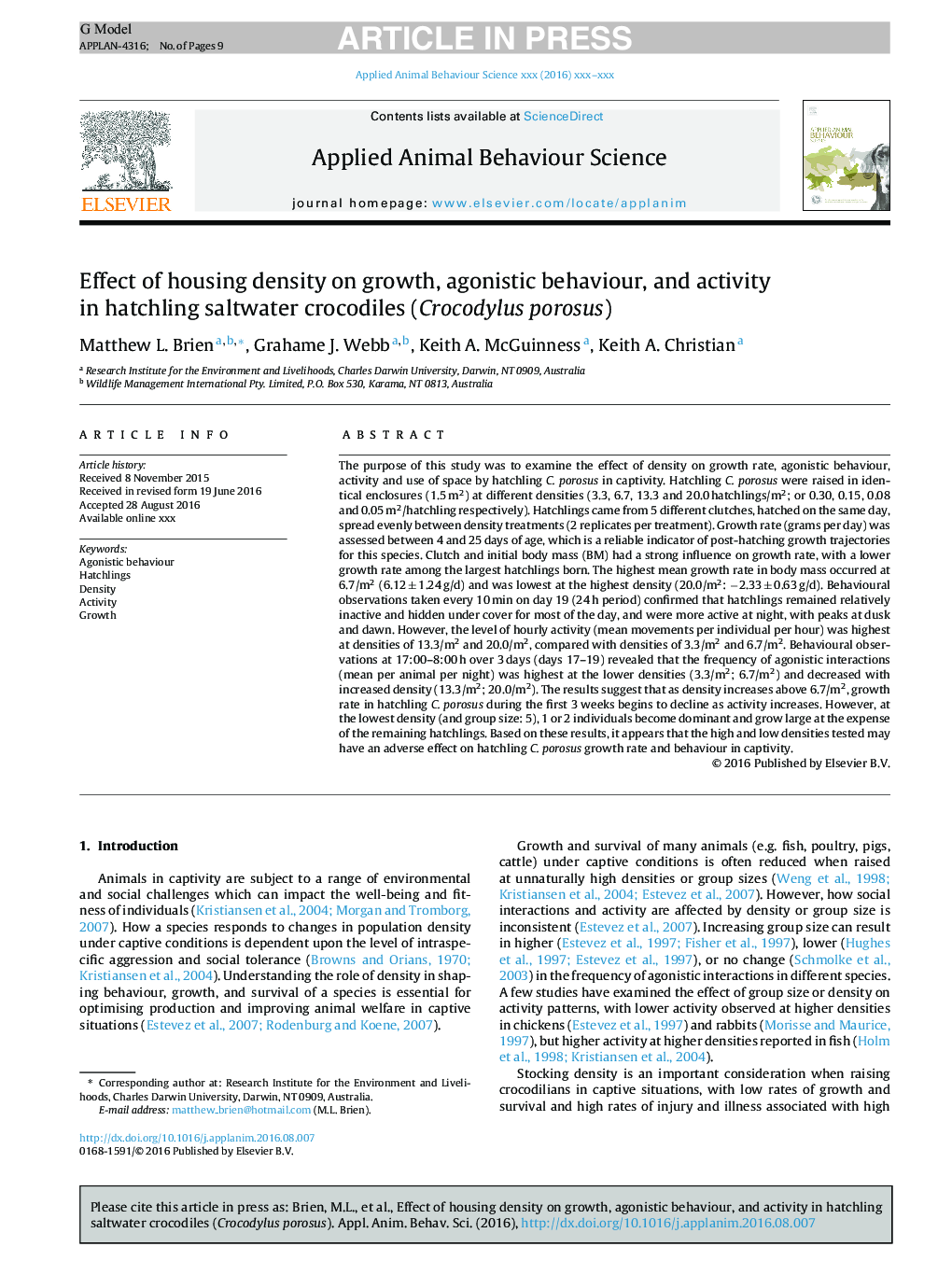| کد مقاله | کد نشریه | سال انتشار | مقاله انگلیسی | نسخه تمام متن |
|---|---|---|---|---|
| 6379236 | 1625322 | 2016 | 9 صفحه PDF | دانلود رایگان |
عنوان انگلیسی مقاله ISI
Effect of housing density on growth, agonistic behaviour, and activity in hatchling saltwater crocodiles (Crocodylus porosus)
دانلود مقاله + سفارش ترجمه
دانلود مقاله ISI انگلیسی
رایگان برای ایرانیان
کلمات کلیدی
موضوعات مرتبط
علوم زیستی و بیوفناوری
علوم کشاورزی و بیولوژیک
علوم دامی و جانورشناسی
پیش نمایش صفحه اول مقاله

چکیده انگلیسی
The purpose of this study was to examine the effect of density on growth rate, agonistic behaviour, activity and use of space by hatchling C. porosus in captivity. Hatchling C. porosus were raised in identical enclosures (1.5 m2) at different densities (3.3, 6.7, 13.3 and 20.0 hatchlings/m2; or 0.30, 0.15, 0.08 and 0.05 m2/hatchling respectively). Hatchlings came from 5 different clutches, hatched on the same day, spread evenly between density treatments (2 replicates per treatment). Growth rate (grams per day) was assessed between 4 and 25 days of age, which is a reliable indicator of post-hatching growth trajectories for this species. Clutch and initial body mass (BM) had a strong influence on growth rate, with a lower growth rate among the largest hatchlings born. The highest mean growth rate in body mass occurred at 6.7/m2 (6.12 ± 1.24 g/d) and was lowest at the highest density (20.0/m2: â2.33 ± 0.63 g/d). Behavioural observations taken every 10 min on day 19 (24 h period) confirmed that hatchlings remained relatively inactive and hidden under cover for most of the day, and were more active at night, with peaks at dusk and dawn. However, the level of hourly activity (mean movements per individual per hour) was highest at densities of 13.3/m2 and 20.0/m2, compared with densities of 3.3/m2 and 6.7/m2. Behavioural observations at 17:00-8:00 h over 3 days (days 17-19) revealed that the frequency of agonistic interactions (mean per animal per night) was highest at the lower densities (3.3/m2; 6.7/m2) and decreased with increased density (13.3/m2; 20.0/m2). The results suggest that as density increases above 6.7/m2, growth rate in hatchling C. porosus during the first 3 weeks begins to decline as activity increases. However, at the lowest density (and group size: 5), 1 or 2 individuals become dominant and grow large at the expense of the remaining hatchlings. Based on these results, it appears that the high and low densities tested may have an adverse effect on hatchling C. porosus growth rate and behaviour in captivity.
ناشر
Database: Elsevier - ScienceDirect (ساینس دایرکت)
Journal: Applied Animal Behaviour Science - Volume 184, November 2016, Pages 141-149
Journal: Applied Animal Behaviour Science - Volume 184, November 2016, Pages 141-149
نویسندگان
Matthew L. Brien, Grahame J. Webb, Keith A. McGuinness, Keith A. Christian,